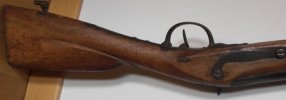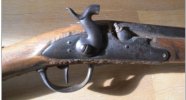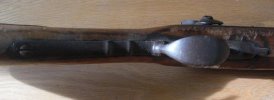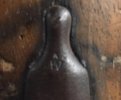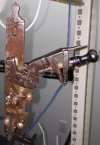- Joined
- Aug 16, 2011
- Messages
- 1,386
I try to be mindful of where my hands are at all time when messing with this thing, if some component does catastrophically fail I want to be sure it doesn't take a finger with it!
I've got a question for you Mr Bookie: as I understand it, when I pull the cock back far enough to fully expose the sear hole, the sear should pop out and keep the cock from moving forward until I pull the trigger. My question is: what pushes the sear through the hole when you pull back the cock? Is it the tumbler? Or is some leaf spring supposed to do it? Because even with the cock fully back that sear doesn't pop out. Nothing's impeding it, but also nothing's pushing it out as far as I can tell.
I think all this lock would need to be operational is to be completely disassembled, each component wiped off with damp cloth, the reassembled with a drop of oil here and there.
I've got a question for you Mr Bookie: as I understand it, when I pull the cock back far enough to fully expose the sear hole, the sear should pop out and keep the cock from moving forward until I pull the trigger. My question is: what pushes the sear through the hole when you pull back the cock? Is it the tumbler? Or is some leaf spring supposed to do it? Because even with the cock fully back that sear doesn't pop out. Nothing's impeding it, but also nothing's pushing it out as far as I can tell.
I think all this lock would need to be operational is to be completely disassembled, each component wiped off with damp cloth, the reassembled with a drop of oil here and there.

